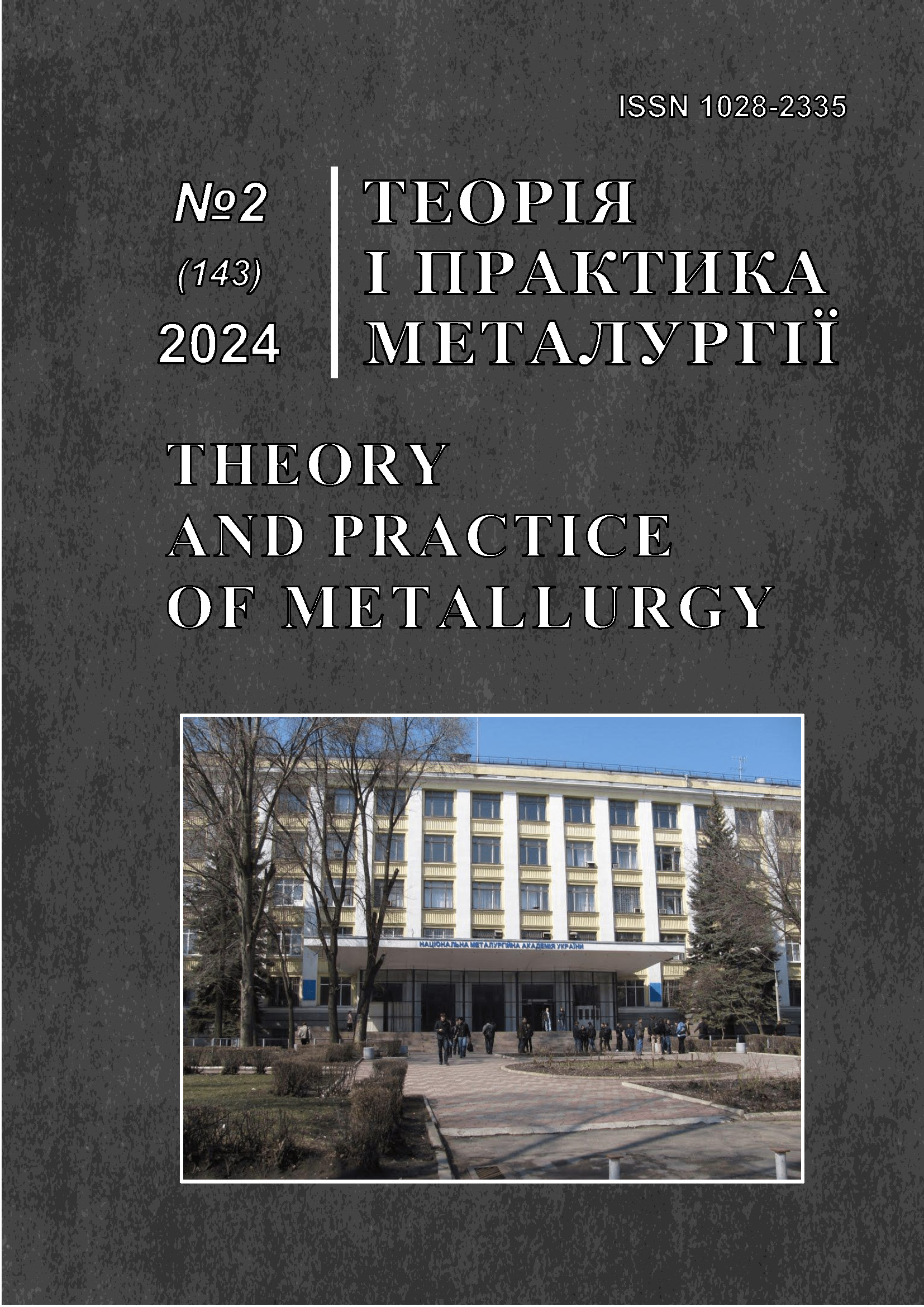Coordinated control of the composition of 01YUT steel and deformation processing modes to achieve specified mechanical properties
DOI:
https://doi.org/10.15802/tpm.2.2024.06Keywords:
YUT low-carbon steel, nitrogen, nitrides, vacuuming, oxidation, method of physicochemical modelingAbstract
Purpose: to investigate the influence of the chemical composition of steel on the output from the chipboard and to establish rational parameters of deoxidation and deformation to ensure the specified values of mechanical properties. Methods: physicochemical modeling, thermodynamic calculations, experimental studies. Results: the carbon content and the degree of oxidation of the semi-finished product from the electric furnace for further vacuum treatment to obtain low-carbon steel were determined. With an increase in the oxygen flow rate supplied to the chipboard and exceeding the value required for the stoichiometry of fuel combustion reactions, the oxidation of the semi-finished product increases. To avoid the formation of calcium silicates, it is necessary to have an active oxygen content below 2.5 ppm, which is ensured by the residual content of dissolved aluminum in steel of 0.025-0.027%. Scientific novelty: The use of complex deoxidizers in steel production allows using the synergistic effect of the joint deoxidizing action of deoxidizing elements. The use of the methodology of physicochemical modeling made it possible to effectively solve the problem of predicting the properties of steel. To study the influence of modifier elements, as well as the main alloying components, a number of parameters characterizing the state of the alloy as a whole (Zy, d) were calculated. Based on information on the significant influence of the chemical composition of the steel on its properties, a database of 150 compositions was prepared to determine the optimal composition of ultra-low-carbon steels of the 01YUT, 01YUTA type by the method of physicochemical modeling. Based on the calculations, the concentrations of elements for steels of the 01YUT and 01YUTA grades were selected.
References
Proidak, Yu. S., Kamkyna, L. V., Stovpchenko, A. P., Stohnyi, Yu. D., & Hryshchenko, Yu. N. (2010). Rafinirovanie nizkouglerodistoi elektrostali pri vnepechnoi obrabotke na UKP. Metallurgicheskaia i gornorudnaia promyshlennost, (7), 218-220
Jin, P., Jiang, Z., Bao, C., Hao, S., & Zhang, X. (2017). The energy consumption and carbon emission of the integrated steel mill with oxygen blast furnace. Resources, Conservation and Recycling, 117, Part A, 58-65. https://doi.org/10.1016/j.resconrec.2015.07.008
Birat, J.-P. (2001). Impact of steelmaking and casting technologies on processing and properties of steel. Ironmaking and Steelmaking, 28(2), 152-158
Stohnyi, Yu. D., Stovpchenko, A. P., Proidak, Yu. S., & Kamkyna, L. V. (2010). Analyz vlyianyia tekhnolohycheskykh parametrov plavky y ratsyonalnye rezhymy poluchenyia nyzkouhlerodystoi staly. Systemni tekhnolohii, (3), 156-162
Fan, Z., & Friedmann, S. J. (2021). Low-carbon production of iron and steel: Technology options, economic assessment, and policy. Review. Joule, 5(4), 829-862. https://doi.org/10.1016/j.joule.2021.02.018
Toktarova, A., Karlsson, I., Rootzén, J., Göransson, L., Odenberger, M., & Johnsson, F. (2020). Pathways for Low-Carbon Transition of the Steel Industry – A Swedish Case Study. Energies, 13(15), 3840. https://doi.org/10.3390/en13153840
Orth, A., Anastasijevic, N., & Eichberger, H. (2007). Low CO2 emission technologies for iron and steelmaking as well as titania slag production. Minerals Engineering, 20(9), 854-861. https://doi.org/10.1016/j.mineng.2007.02.007
Kempken, I., & Pliushkel, V. (1996). Modelnye raschety izmeneniia soderzhaniia azota v stali po khodu produvki v konvertere LD. Chernye metally, (1), 23-30
Wang M., Bao Y., Yang Q., Zhao L., & Lin L. (2015). Coordinated control of carbon and oxygen for ultra-low-carbon interstitial-free steel in a smelting process. International Journal of Minerals, Metallurgy, and Materials, 22(12), 1252–1259. https://doi.org/10.1007/s12613-015-1192-x
Deo, B., Overbosch, A., Snoeijer, B., Das, D., & Srinivas, K. (2013). Control of sla g formation, foaming, slopping, and chaos in BOF. Trans. Indian Inst. Met., 66(5), 543
Deo, B., Karamchetty, A., Paul, A., Singh, P., & Chhabra, R. P. (1996). Characterization of slag-metal dropletgas emulsion in oxygen steelmaking converters. ISIJ Int., 36(6), 658
Tang, F. P., Li, Z., Wang, X. F., Chen, B. W., & Feim P. (2011). Cleaning IF molten steel with dispersed in-situ hetero-phases induces by the composite sphere explosive reaction in RH ladles. Int. J. Miner. Metall. Mater., 18(2), 144
He, Z., Jin, Y., Liu, J., & Guan, Z. (2012). Technology study of smelting the super-lowcarbon stainless steel with vod refining furnace. Metalurgia International, XVII(2)
Turkdogan, E. T. (1996). Fundamentals of Steelmaking. The University Press
Ashok, K., Mandal, G. K., & Bandyopadhyay, D. (2015). Theoretical Investigation on Deoxidation of Liquid Steel for Fe-Al-Si-O System. Transactions of the Indian Institute of Metals, 68, 9-18. http://link.springer.com/article/10.1007%2Fs12666-015-0574-0#page-2
Malyutin, K. V., & Paderin, S. N. (2007). Interaction Parameters of carbon in Liquid Iron and Thermodynamics of Carbon and Oxygen in Alloyed Iron Melts. Russian Metallurgy (Metally), 2007(7), 545-551
Prykhodko, E. V. (1983). Metallokhimiia kompleksnogo legirovaniia. Metallurgiia
Downloads
Published
How to Cite
Issue
Section
License
Copyright (c) 2024 Velychko O.G., Kamkin V.Yu., Proidak Yu.S.

This work is licensed under a Creative Commons Attribution 4.0 International License.
Authors retain copyright of the published papers and grant to the publisher the non-exclusive right to publish the article, to be cited as its original publisher in case of reuse, and to distribute it in all forms and media. Articles will be distributed under the Creative Commons Attribution 4.0 International (CC BY 4.0) licence.
Authors can enter the separate, additional contractual arrangements for non-exclusive distribution of the published paper (e.g., post it to an institutional repository or publish it in a book), with an acknowledgement of its initial publication in this journal.




